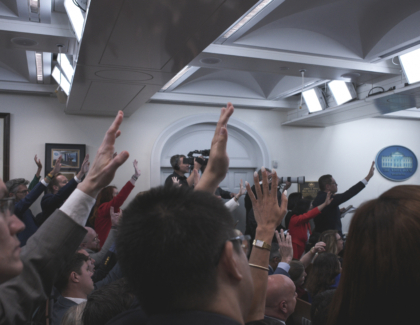Sign up for the daily CJR newsletter.
“She came off like America’s mom.” “Reminiscent of Reagan’s message of that Shining City on a Hill.” “His speech was tone deaf. Hers was the perfect pitch.” These were all reviews of Alabama Senator Katie Britt’s official Republican response to President Biden’s State of the Union address on Thursday night—lines crafted by allies and distributed to sympathetic conservative influencers before Biden or Britt had even uttered a word, according to the New York Times. When it finally came time for Britt to speak, her address was less shining city on a hill and more failed country in the gutter. She painted Biden’s America as a violent hellscape overrun by undocumented immigrants. And the cadence of her delivery was not so much the perfect pitch as that of an overwrought one-woman play off-off-off Broadway.
In the press, the recaps and (real) reviews quickly poured in, many of them focused on Britt’s rhetorical style. They weren’t all bad: on CBS, Margaret Brennan said that Britt is “known for being a substantive person on the issues”; a headline in Voice of America described Britt’s address as “spirited.” (Republicans chose Britt to deliver their rebuttal, the story read—“and deliver she did.”) Mostly, though, the reviews were bad. “With a sunny, inviting smile, Senator Katie Britt of Alabama welcomed Americans into her kitchen on Thursday night,” the Times wrote—but “many soon backed away nervously,” amid a “tonally jarring” speech that, among other lines, went into “grim detail about a child victim of sex trafficking by drug cartels.” The Atlantic’s Elaina Plott Calabro deemed the speech “strange,” and out of step with Britt’s reputation for being “startlingly, well, normal.” As social-media commenters poured on further scorn, journalists aggregated their posts into content. By Saturday night, Scarlett Johansson was parodying Britt on SNL. By Sunday night, Jimmy Kimmel was mocking her at the Oscars.
Some analysis of the address drafted it into the endless debate over polarization in America. “The senator’s performance may have given me a morning migraine,” the Times columnist Michelle Cottle wrote. “But I’m guessing there were plenty of other folks, including much of the MAGAverse, who found it spot-on.” Indeed, Donald Trump and various acolytes praised Britt, at least in public. But—as articles in various major publications proclaimed—even many right-wingers found the speech excruciating. A “source close to Trump” told the Daily Beast that it was “the stuff of nightmares.” “I don’t know what the eff I saw,” Megyn Kelly said on SiriusXM. On one conservative network, the initial reaction to the speech was one of stunned silence.
A nation, finally, seemed to agree about something. But amid all the mockery, one reaction to Britt’s address increasingly stood out—and it had little to do with her weird delivery. In a video posted to TikTok on Friday, Jonathan Katz, an independent journalist who once worked at the Associated Press and now writes the newsletter The Racket, patiently fileted a particular claim that Britt had made—specifically the one that went into grim detail about a child victim of sex trafficking by drug cartels. Britt recounted meeting in Texas with an activist who had been trafficked starting at the age of twelve, then strongly implied that this had happened as a result of the Biden administration’s approach to the border. (“We wouldn’t be okay with this happening in a third-world country,” Britt said, angrily. “This is the United States of America.”) Following a rudimentary online search, however, Katz found that the victim Britt was talking about had been trafficked in Mexico between 2004 and 2008, when George W. Bush was the US president.
Katz’s fact check went viral and has since reframed much topline coverage of Britt’s address, with major outlets now questioning its accuracy at least as prominently as its idiosyncratic tone. Even Johansson nodded, in her SNL parody, to Katz’s reporting; appearing on Fox News Sunday yesterday, Britt was asked about her anecdote and essentially confirmed the essence of Katz’s reporting despite rhetorically doubling down. Among avid journalism-watchers, at least, Katz’s work also turned Britt’s speech into a media story—one dragging in weighty themes from the dire state of the news business to the perceived complicity of political journalists in Republican deception. As I see it, the episode also, to some extent, points to the decline of the fact check, and the rise—or, at least, the stubborn persistence—of the ‘vibe check.’
Numerous observers questioned why it had taken Katz—a freelance journalist posting to social media—to undermine Britt’s claim when much better-resourced newsrooms have legions of reporters whose ostensible job it is to do so. (Especially given how little time it took Katz to establish the context for Britt’s anecdote; he later described the task as “the fastest investigation I think I’ve ever done.”) Major outlets clearly agree that Britt’s false claim is a big story, judging by their subsequent scramble to cover it. (The Times phoned the activist at the center of Britt’s story, who said that she’d learned about it from social media and found the whole thing “very strange.”) Several of these outlets prominently credited Katz in their coverage. Others did so as an afterthought or not at all, while using voice-of-God language that suggested Britt’s claim had, as if entirely naturally, become the subject of “questions,” “scrutiny,” “criticism,” and “backlash.”
That it took Katz to fact-check Britt’s claim was not, as some observers have implied, a failure of “the media,” if only because Katz is very much a member of the media and not just some random guy on TikTok—indeed, Katz is a very well-known journalist and TikTok is a perfectly legitimate mechanism for the delivery of journalism (even if a lot of what gets delivered on the platform is not legitimately journalism). In his video, Katz showed how the platform can be effective for sharing news in a transparent way, flashing up his research on-screen as he talked viewers through it. Still, it is fair to ask why major newsrooms didn’t get to the story first. In an interview with Maria Bustillos for Flaming Hydra, a cooperative for independent publishers to which Bustillos and Katz both belong, Katz welcomed the “democratization” of media—but also suggested that the barriers to doing journalism online are now so low because the professional journalism industry has been decimated financially. “The good news is no matter what your background, no matter where you come from, you too can make no money,” Katz quipped. “There should be newspapers that we work at where we do this,” he added.
Having more newsrooms, while a very good idea, isn’t itself a cure for the sort of journalistic groupthink that can lead to collective oversights like this one. And it’s only fair to point out that the well-resourced newsrooms we already have weren’t totally asleep at the wheel here. Outlets including the Washington Post, CNN, and the New York Times all ran rigorous, quick fact checks of Biden’s State of the Union address; the Times also checked at least two (albeit fairly general) claims from Britt’s response, which was also the subject of some checking by PolitiFact and by MSNBC’s Rachel Maddow (who pointed out on air that for all her complaints about Biden’s border policies, Britt abandoned a bipartisan Senate bill aimed at reforming them after Trump came out against it). Fact-checkers then followed up on Katz’s reporting on the specific sex-trafficking claim. The Post’s Glenn Kessler awarded it “Four Pinocchios”—a metric intended to categorize a lie as particularly egregious.
Still, pre-Katz, at least, any fact-checking of Britt’s speech was a much smaller story across the mediasphere than its delivery. This strikes me, at least to some extent, as a departure from the golden age of fact-checking under Trump, when a practice about as old as journalism itself took off as a focused pursuit—and a media story in its own right—in response to Trump’s prolific lying, making mini-media celebrities of Kessler and some of his counterparts. If those days are over, that isn’t necessarily a bad thing. Even at the time, some observers, including CJR’s Ana Marie Cox, criticized the obsession with fact-checking as overly focused on petty minutiae at the expense of more urgent truths that are harder to pin down. “Pinocchios give readers an impression that the only thing that matters about a claim is the degree to which it is true,” Cox wrote. In reality, other things matter, too, including who makes a claim, and, yes, how. (If nothing else, Britt’s delivery of her speech was indeed very funny. We could all use a laugh right now.)
On this occasion, though, Britt used a specific, shockingly violent claim to undergird a much bigger narrative about immigration. As The New Yorker’s Jonathan Blitzer suggested to my colleague Kevin Lind recently, too much mainstream media coverage of that subject is already organized more around how partisans feel about it than specific factual assessments—a problem surely exacerbated by how complicated a policy area immigration can be. Those specifics really matter. The immigration debate needs more light, and less misleading heat.
More broadly, Bustillos put it to Katz, in their discussion for Flaming Hydra, that a tendency to prioritize “pure vibes” over verifiable facts has crossed over from the MAGA media universe and “infected” mainstream media institutions. To be sure, political coverage has always been concerned with optics, and that’s always been especially true of the rebuttal to the State of the Union; Marco Rubio’s 2013 effort is still better remembered (if the coverage of Britt’s speech is any guide) for the way he took a drink of water than anything he said. By hamming things up, Britt only made the theater-criticism nature of the coverage seem more on the nose. Still, it’s not hard to imagine a media moment, not so long ago, when more journalists might have been tasked with checking her specific claims sooner, and with greater prominence. If they had, those claims might instantly have defined her speech, in addition to its weird tone. Thanks to Katz, they still might.
Other notable stories:
- Yesterday, Kensington Palace released a photo of Kate Middleton—the princess of Wales, who has been out of the public eye for weeks after undergoing abdominal surgery—to mark Britain’s Mother’s Day. The release of the photo may also have been designed to quieten conspiracy theories that have exploded online as to her true condition and whereabouts. But the photo itself quickly became the subject of much online discussion since it appeared to have been doctored in several places; later, various news agencies withdrew it from circulation on their wires, suggesting that it had been manipulated by the source. This morning, a statement posted to social media in the princess’s name suggested that she, like other “amateur photographers,” likes to “experiment with editing,” and apologized for any confusion that the photo caused.
- Recently, Benjamin Mullin, of the Times, reported that the Center for Public Integrity, a venerable nonprofit newsroom, was considering “merging with a competitor or shutting down amid turmoil in its top ranks and financial difficulties.” Mullin now reports that the Center is laying off an unspecified number of staffers amounting to less than half of the organization. In other media-business news, Colorado Public Radio laid off fifteen employees last week, also citing financial challenges; the Colorado media-watcher Corey Hutchins has more. And yesterday, the LA Times was printed for the final time at the downtown plant it once owned. Going forward, the paper will outsource printing to the Southern California Newspaper Group; Thomas Curwen has more details.
- Mark Katches, the editor of the Tampa Bay Times, reports that the city’s fire chief recently called the police on Justin Garcia, a reporter at the paper who showed up at the fire department’s headquarters to request public records related to the recent termination of an employee. Staffers told Garcia that he would have to submit a request online, even though Florida law expressly allows citizens to ask for documents in person, Katches writes; the police were then called, though Garcia had left the premises by the time they arrived. “Journalists are supposed to ask questions and seek explanations,” Katches writes. “That may rankle people in power, but it doesn’t constitute an unruly disturbance.”
- The New Yorker debuted Fault Lines, a new weekly column, by Jay Caspian Kang, that will explore “media, politics, and who wields power in a world transformed by new technologies.” In the debut edition, Kang argues that the “ideology of the Internet” rules our age more than we fully admit. “An optimist might invoke the idea of democratization, pointing to the medium’s ability to amplify otherwise silent voices, in ways both good and bad,” Kang writes, of this ideology. “But the Internet is not so much a forum as a language unto itself, one with its own history, predilections, and prejudices.”
- And for Politico, Gabe Fleisher dug into @ringwiss—an anonymous user on X whose deep knowledge of arcane Congressional procedure has become a “go-to resource for staffers, lobbyists and reporters across Washington”—and found that the account belongs not to a Capitol staffer, but to Kacper Surdy, a twenty-year-old student in the UK. Surdy’s posts have proven particularly useful at a time “when lawmakers have been stretching procedures to novel ends and increasingly bucking leadership.”
ICYMI: How do you cover a candidate everyone knows—and no one remembers?
Correction: This post has been updated to clarify that the Washington Post’s “Four Pinocchios” metric predates the Trump administration.
Has America ever needed a media defender more than now? Help us by joining CJR today.







